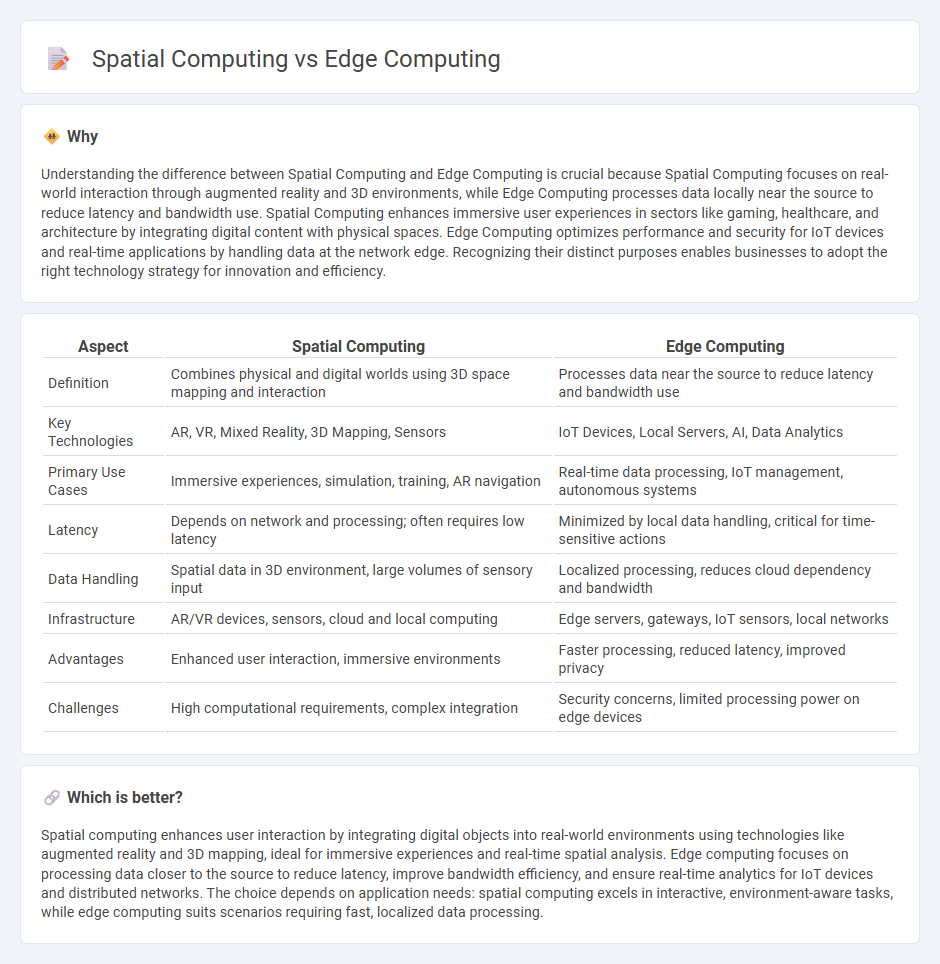
Spatial computing integrates digital content with physical environments through technologies like AR, VR, and IoT to create immersive, real-world experiences. Edge computing processes data closer to the data source, reducing latency and enhancing real-time analysis for applications like autonomous vehicles and smart cities. Explore how spatial computing and edge computing are transforming industries by pushing the boundaries of interaction and data processing.
Why it is important
Understanding the difference between Spatial Computing and Edge Computing is crucial because Spatial Computing focuses on real-world interaction through augmented reality and 3D environments, while Edge Computing processes data locally near the source to reduce latency and bandwidth use. Spatial Computing enhances immersive user experiences in sectors like gaming, healthcare, and architecture by integrating digital content with physical spaces. Edge Computing optimizes performance and security for IoT devices and real-time applications by handling data at the network edge. Recognizing their distinct purposes enables businesses to adopt the right technology strategy for innovation and efficiency.
Comparison Table
| Aspect | Spatial Computing | Edge Computing |
|---|---|---|
| Definition | Combines physical and digital worlds using 3D space mapping and interaction | Processes data near the source to reduce latency and bandwidth use |
| Key Technologies | AR, VR, Mixed Reality, 3D Mapping, Sensors | IoT Devices, Local Servers, AI, Data Analytics |
| Primary Use Cases | Immersive experiences, simulation, training, AR navigation | Real-time data processing, IoT management, autonomous systems |
| Latency | Depends on network and processing; often requires low latency | Minimized by local data handling, critical for time-sensitive actions |
| Data Handling | Spatial data in 3D environment, large volumes of sensory input | Localized processing, reduces cloud dependency and bandwidth |
| Infrastructure | AR/VR devices, sensors, cloud and local computing | Edge servers, gateways, IoT sensors, local networks |
| Advantages | Enhanced user interaction, immersive environments | Faster processing, reduced latency, improved privacy |
| Challenges | High computational requirements, complex integration | Security concerns, limited processing power on edge devices |
Which is better?
Spatial computing enhances user interaction by integrating digital objects into real-world environments using technologies like augmented reality and 3D mapping, ideal for immersive experiences and real-time spatial analysis. Edge computing focuses on processing data closer to the source to reduce latency, improve bandwidth efficiency, and ensure real-time analytics for IoT devices and distributed networks. The choice depends on application needs: spatial computing excels in interactive, environment-aware tasks, while edge computing suits scenarios requiring fast, localized data processing.
Connection
Spatial computing integrates real-world physical environments with digital data, requiring rapid processing of location-based information. Edge computing supports spatial computing by processing data closer to the source, reducing latency and enabling real-time analysis for applications like augmented reality and autonomous vehicles. The synergy between spatial and edge computing drives enhanced performance in immersive experiences and smart environments.
Key Terms
Data Processing Location
Edge computing processes data near the source, typically on local devices or edge servers, minimizing latency and bandwidth usage for real-time applications. Spatial computing integrates digital and physical environments, often relying on distributed processing across sensors, AR/VR devices, and cloud resources to interpret spatial data. Explore the distinctions in data processing locations and their impact on system performance to gain deeper insights.
Real-time Interaction
Edge computing processes data closer to the source, minimizing latency and enabling real-time interactions for applications like autonomous vehicles and smart grids. Spatial computing integrates physical and digital environments directly, enhancing real-time user experiences through augmented reality and 3D mapping. Explore how these technologies revolutionize real-time interaction by visiting our detailed analysis.
Context Awareness
Edge computing processes data near the source to reduce latency and improve real-time responsiveness, enhancing context-aware applications by enabling faster decision-making at the device level. Spatial computing combines digital and physical environments through sensors and spatial data, delivering immersive and contextually rich user experiences by understanding the surrounding environment in real time. Explore the differences in how these technologies leverage context awareness to advance future computing capabilities.
Source and External Links
What is edge computing? | Glossary | HPE - Edge computing stores and processes data closer to the user at the network's edge using devices like IoT sensors or local servers, reducing latency and improving real-time processing in applications like smart cities and self-driving cars.
What Is Edge Computing? | Microsoft Azure - Edge computing enables devices in remote locations to process data locally or on nearby servers to minimize latency and send only relevant data to central datacenters, supporting real-time actions in environments with limited connectivity.
What Is Edge Computing? - IBM - Edge computing is a distributed framework that brings applications closer to data sources like IoT devices, reducing latency and bandwidth use, and enabling faster, deeper insights especially as data volumes grow and 5G expands.
 dowidth.com
dowidth.com